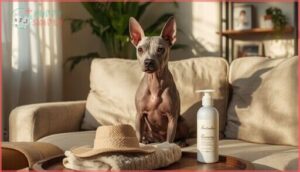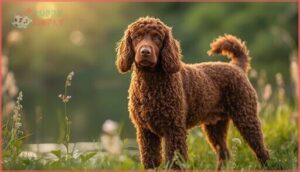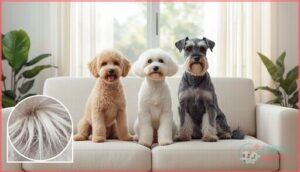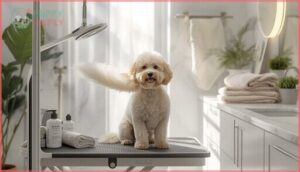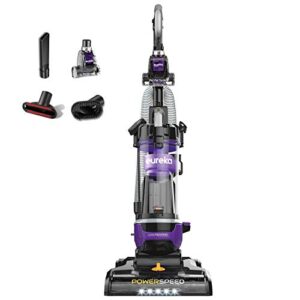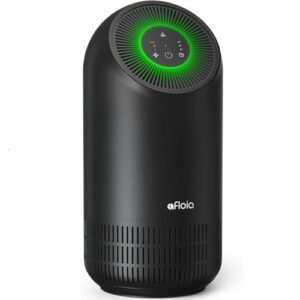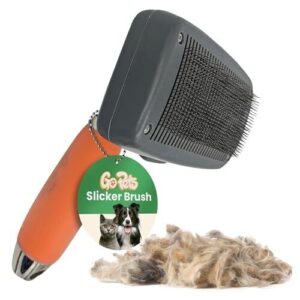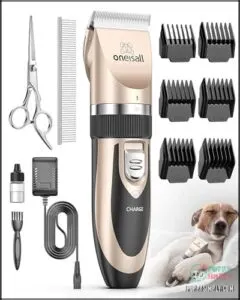This site is supported by our readers. We may earn a commission, at no cost to you, if you purchase through links.
Dogs with sneezing owners face an unfair dilemma. You want the companionship, but your immune system launches a full-scale protest every time fur flies. The good news is that certain affable dog breeds that are hypoallergenic produce markedly less dander—the actual culprit behind most pet allergies.
These breeds combine low-shedding coats with genuinely friendly temperaments, so you don’t have to choose between a warm personality and breathing clearly. From curly-coated Poodles to the cheerful Bichon Frise, hypoallergenic breeds trap loose hair and dander in their coats instead of broadcasting it around your home.
With proper grooming and the right approach to allergen management, you can enjoy life with a loyal, affectionate companion without the constant tissue box.
Table Of Contents
- Key Takeaways
- Most Affable Hypoallergenic Dog Breeds
- Key Traits of Hypoallergenic Dog Breeds
- Best Hypoallergenic Breeds for Families
- Grooming and Care Tips for Allergy Sufferers
- Top 4 Products for a Hypoallergenic Dog Home
- Frequently Asked Questions (FAQs)
- Can I adopt a hypoallergenic dog from a shelter?
- How do I travel with a hypoallergenic dog breed?
- What are the costs associated with owning a hypoallergenic dog?
- Are there specific health issues for hypoallergenic breeds I should know?
- Can I train a hypoallergenic dog to be a therapy dog?
- Can hypoallergenic dogs still trigger allergy symptoms?
- How often should hypoallergenic dogs be bathed?
- Are hypoallergenic breeds more expensive to maintain?
- Do hypoallergenic dogs require special diets?
- Which hypoallergenic breed is best for apartments?
- Conclusion
Key Takeaways
- Hypoallergenic dog breeds produce less dander through low-shedding, single-layer, or curly coats that trap allergens rather than releasing them into your home, though no breed eliminates allergens completely.
- Twice-weekly bathing reduces recoverable allergens by 84-86%, while daily brushing and professional grooming every 4-6 weeks provide the most effective allergen control for allergy sufferers.
- Breeds like Poodles, Bichon Frises, and Portuguese Water Dogs combine hypoallergenic traits with friendly, trainable temperaments that adapt well to families with children and other pets.
- Managing a hypoallergenic dog home requires HEPA air purifiers, regular vacuuming with pet-specific tools, and consistent grooming practices to maintain both your dog’s coat health and your household’s air quality.
Most Affable Hypoallergenic Dog Breeds
If you’re looking for a dog that’s both friendly and easier on your allergies, you’re in luck. These breeds combine affable temperaments with coat types that produce less dander and shed minimally.
Here are ten hypoallergenic dogs that bring warmth to your home without overwhelming your immune system.
Poodle (Toy, Miniature, Standard)
Poodles stand out as exceptionally hypoallergenic pets because their curly coats trap dander instead of releasing it into your home. Standard Poodles offer the lowest allergen levels, while Miniature and Toy varieties work well too.
These intelligent, trainable dogs bond deeply with families and stay calm around children. Regular grooming every four to six weeks keeps dander minimal, making Poodles ideal low-shedding dogs for allergy sufferers seeking affectionate companionship.
Understanding hypoallergenic qualities is key to managing allergies with these breeds.
Bichon Frise
If you’re searching for hypoallergenic dogs that combine charm with allergy-friendly traits, the Bichon Frise earns high marks. This small breed’s curly, double coat traps shed hairs and dander, reducing allergen spread in your home.
Bichon training responds well to positive methods, and proper Frise nutrition bolsters skin health. Their playful, gentle temperament makes them outstanding low shedding dogs for families managing pet allergies while seeking affectionate companionship.
For more information on the Bichon Frise breed, including its classification in the Non Sporting Group, can help owners understand its needs.
Soft-Coated Wheaten Terrier
Another standout among hypoallergenic breeds is the Soft Coated Wheaten Terrier, weighing 30–40 pounds with a silky, single-layer coat that sheds minimally. This Irish farm dog’s friendly, people-oriented temperament fits active families managing dog allergies.
Regular brushing prevents mats, and proper Wheaten Care—including balanced Dog Nutrition and consistent Terrier Training—aids skin health. Their Breed History as adaptable workers explains their affable, eager-to-please nature, making them ideal low shedding dogs for allergy-conscious households.
Portuguese Water Dog
If you want a lovable, athletic companion, the Portuguese Water Dog brings energy and loyalty to allergy-conscious homes. This medium-sized breed’s curly, single-layer coat is truly low-shedding, trapping dander close to the skin instead of releasing it into your space.
Expect daily exercise—swimming and fetch top the list—and regular brushing to prevent mats.
Their Breed History as Portuguese fishermen’s helpers explains their trainability, making Dog Training and Water Therapy natural fits for this affectionate, family-friendly choice.
Bedlington Terrier
If you’re drawn to a breed that blends lamb-like charm with terrier spunk, the Bedlington Terrier stands out among hypoallergenic dog breeds. Its single-layer coat traps dander, making it a top low-shedding choice for dog allergies.
Why Bedlington Care works for allergy sufferers:
- Minimal shedding keeps your home fur-free
- Regular grooming controls allergens effectively
- Affectionate temperament suits families (4/5 AKC rating)
- Terrier training channels playful energy
- Dog socialization shapes their selective friendliness
Expect professional clipping every six weeks and daily brushing to prevent mats.
American Hairless Terrier
For dog allergies, the American Hairless Terrier brings a unique twist—no traditional coat means less dander clinging to fur. This hypoallergenic dog breed originated in the Southern U.S., and its hairless care requires weekly baths with moisturizing shampoo plus sun protection outdoors.
| Trait | Detail | Why It Matters |
|---|---|---|
| Size | 12–16 inches, 12–28 lbs | Perfect lap-dog energy |
| Lifespan | 13–16 years | Long companionship |
| Temperament | Energetic, affectionate | Thrives with active families |
Terrier training channels their curiosity, while proper dog nutrition and allergy management keep skin healthy in these low-shedding dogs.
Irish Water Spaniel
This Irish Water Spaniel thrives as one of the rare hypoallergenic dog breeds, shedding less than monthly while its curly coat traps 70% of airborne allergens. Spaniel care includes professional grooming every 6–8 weeks, plus breed history shows centuries of low-shedding traits. Training tips: start socialization early for maximum friendliness.
- Size: 21–24 inches, 45–68 lbs
- Lifespan: 12–15 years with proper dog nutrition
- Exercise: 60–90 minutes daily swimming or running
- Temperament: Loyal, playful, intelligent problem-solver
Maltese
You’ll fall in love with the Maltese if you need hypoallergenic dogs that fit snugly in your lap. This toy-sized breed weighs just 4–7 pounds and produces minimal dander thanks to its hair-like single-layer coat.
Maltese temperament shines through playful affection, making them allergy-friendly breeds for apartments. Coat maintenance demands daily brushing and baths every three weeks to keep low-shedding benefits intact while managing tear staining.
Miniature Schnauzer
Looking for hypoallergenic dogs that pack personality into miniature size? The Miniature Schnauzer stands out with a wiry double coat that sheds minimally, trapping dander and loose hair.
This breed weighs 11–20 pounds and thrives on Schnauzer training—they’re keen to please and highly intelligent.
Regular grooming every 4–8 weeks controls allergens while supporting their 12-year average lifespan. Watch for health issues like periodontal disease and maintain proper dog nutrition to prevent obesity.
Yorkshire Terrier
If you’re hunting for a pint-sized companion among hypoallergenic dogs, the Yorkshire Terrier delivers affection in a silky, low-shedding coat that keeps allergens at bay. This breed’s history traces back to Victorian England, where ratters evolved into devoted lap dogs.
- Daily brushing prevents matting and controls pet allergies
- Yorkshire Training rewards their above-average intelligence
- Terrier Nutrition and dog socialization support their 13-year lifespan
Watch for portosystemic shunt and dental disease in toy breeds.
Key Traits of Hypoallergenic Dog Breeds
Not all hypoallergenic dogs are created equal, but they do share some common features that make them easier on your allergies. Understanding these traits helps you know what to expect before bringing a low-allergen breed into your home.
Let’s break down the key characteristics that set these dogs apart.
Low-Shedding and Non-Shedding Coats
You’ll find that true hypoallergenic breeds share a defining trait: coats that release far less hair into your home. These low-shedding breeds generally have hair with extended growth phases—Poodles, for instance, may hold individual strands for years rather than months. Single-layer, curly coats also trap loose hairs within the curl, preventing widespread allergen distribution and reducing visible shedding compared to double-coated dogs.
| Coat Texture | Shedding Patterns |
|---|---|
| Single-layer curly | Minimal, year-round release |
| Wiry topcoat | Low routine hair loss |
| Soft, silky waves | Continuous but stable drop |
| Tight curls | Hair retained in coat |
| Hair-like strands | Extended growth cycles |
Minimal Dander Production
You’ve chosen a low-shedding coat, but dander reduction matters more for your allergies. Hypoallergenic dogs don’t eliminate dander—they produce less of it.
Recent allergen testing shows individual variation outweighs breed differences: some Poodles release more pet dander than Labrador Retrievers. Breeding innovations and coat variations influence output, yet dander measurement confirms no nonshedding coat guarantees allergy-friendly breeds.
Managing skin health reduces allergen loads across all dogs.
Single-Layer and Curly Coats
Coat Structure explains why curly hair works differently than straight. Single Layer Grooming stays simpler—breeds like Poodles and Portuguese Water Dogs skip the undercoat that doubles your cleanup. Their curls trap loose strands and dander close to the skin, offering Allergen Trapping advantages over straight-haired dogs. Curly Coat Benefits include Dander Reduction through containment rather than elimination.
- You’ll notice less dog hair drifting across your furniture with these LowShedding companions
- Their nonshedding coat keeps allergens bundled until your next brushing session
- These allergy friendly breeds need consistent dog grooming to maintain their natural defenses
Grooming Requirements for Allergen Control
Keeping allergens in check demands deliberate Shedding Management beyond curly hair. Twice-weekly baths slash recoverable allergens by 84–86% on hair and dander, though airborne levels drop more modestly. Daily brushing and wipe-downs remove loose particles before they float free. Professional Grooming Schedules every 4–6 weeks prevent matting that traps irritants. Pair home Coat Maintenance with HEPA vacuums for maximum Dander Control—consistency beats intensity.
| Grooming Task | Frequency |
|---|---|
| Bathing | Twice weekly |
| Brushing | Daily (5–10 min) |
| Wipe-downs | After outdoor time |
| Professional grooming | Every 4–6 weeks |
Best Hypoallergenic Breeds for Families
Finding a hypoallergenic dog that fits your family isn’t just about low shedding—you need a breed that gets along with kids, fits your lifestyle, and doesn’t require constant supervision.
Some breeds are naturally more patient and trainable than others, making them better matches for households with children or other pets.
Let’s look at the key factors that make certain hypoallergenic breeds stand out for families.
Friendly Temperaments
When you’re looking for hypoallergenic dogs that naturally connect with people, temperament matters as much as coat type. Poodles, Bichon Frises, and Soft-Coated Wheaten Terriers rank among the most sociable low-shedding breeds, with owners reporting above-average friendliness.
These allergy-friendly dogs excel at pet-human bonding, combining canine social skills with reduced dander—making them ideal hypoallergenic pets for families seeking both companionship and allergen control.
Adaptability to Children and Other Pets
Many low shedding breeds adapt well to households with kids and other pets, but supervision remains essential for Child Safety. Poodles, Bichon Frises, and Portuguese Water Dogs usually welcome children through structured Pet Socialization, while Miniature Schnauzers blend watchfulness with gentle Household Dynamics.
For Dog Breeds for Allergy Sufferers, Family Compatibility depends on early introductions and consistent training—not just coat type—supporting both Allergy Management and harmonious multi-pet homes.
Exercise and Activity Needs
You’ll find that exercise needs vary among hypoallergenic breeds, so matching Energy Levels to your lifestyle matters.
Standard Poodles benefit from 45–60 minutes of Daily Exercise and Mental Stimulation, while Maltese thrive on 30–60 minutes split into shorter sessions.
Portuguese Water Dogs crave vigorous Physical Activity—swimming or fetch—and most family dogs show fewer behavioral issues when Play Requirements include both dog training and structured exercise.
Trainability and Intelligence
Intelligent breeds like Poodles and Bichon Frises learn commands in under five repetitions—some even match a young child’s canine problem-solving skills. Positive obedience training with treats boosts trainability factors across hypoallergenic dogs, while harsh methods backfire.
You’ll notice Portuguese Water Dogs and Miniature Schnauzers thrive on mental stimulation, preventing nuisance behaviors and supporting lifelong cognitive development in dog breeds for allergies.
Grooming and Care Tips for Allergy Sufferers
Owning a hypoallergenic dog doesn’t stop at choosing the right breed. Your grooming routine makes all the difference in keeping allergens under control and your symptoms at bay.
Here’s what you need to know about maintaining your dog’s coat and creating a cleaner, more comfortable home for everyone.
Regular Brushing and Bathing
You can cut allergen buildup dramatically with the right grooming rhythm. Daily brushing for 5–10 minutes removes loose hair and dander before it settles into your home, while weekly deep brushing addresses the undercoat where allergens hide.
Bathing your hypoallergenic dog twice weekly drops recoverable allergen by about 85%, keeping your environment cleaner and your symptoms under control.
Managing Skin and Coat Health
A healthy skin barrier keeps allergens locked inside your dog’s coat instead of floating through your home. Omega-3 and omega-6 fatty acid supplements improve the skin’s lipid layer, reducing dander release by up to 65% in dogs with inflammatory skin issues—essential allergy management for low-shedding dogs.
- Skin nutrition from essential fatty acids strengthens barrier function and reduces transepidermal water loss
- Coat supplements like biotin and zinc improve hair quality and reduce scaling in hypoallergenic dogs
- Dermatologic care with barrier-repair products prevents secondary infections that worsen shedding
Preventing Matting and Tangling
After boosting your dog’s skin health, focus on Matting Prevention and Tangle Reduction. Hypoallergenic Dogs—especially Low-Shedding Dogs with curly or long coats—need regular Coat Maintenance.
Use Grooming Tools like slicker brushes and metal combs, brushing two to three times a week. Smart Brushing Techniques target trouble spots, keeping Dog Coat Types smooth.
These simple Canine Grooming Tips protect comfort and skin.
Importance of Professional Grooming
While regular home brushing helps, professional grooming delivers deeper Skin Health and Dander Reduction for Hypoallergenic Dogs. Groomers trained in Professional Tips detect early skin issues and remove allergen-loaded debris more thoroughly.
Studies show dogs groomed professionally experience 40% fewer skin problems and 25% less scratching—key Grooming Benefits for Allergy Prevention.
For Low-Shedding Dogs, expert Canine Grooming Tips and Dog Grooming and Care every six weeks optimize comfort and minimize allergens.
Top 4 Products for a Hypoallergenic Dog Home
Even with a hypoallergenic breed, you’ll still need the right tools to keep allergens under control at home. The products you choose can make a real difference in managing dander, loose hair, and airborne particles.
Here are four essential items that help create a cleaner, more comfortable space for you and your dog.
1. Eureka Powerful Upright Vacuum Cleaner
You’ll appreciate the Eureka PowerSpeed’s 960-watt suction power and 12.6-inch cleaning pathwidth when tackling pet hair removal across multiple floor types. This lightweight upright helps with allergen reduction through its 2.6-liter dust cup and foam filtration system, though it won’t trap fine pet dander as effectively as HEPA-equipped models.
For allergy sufferers, proper vacuum maintenance matters—empty the canister frequently and rinse the washable filter regularly to prevent recirculating allergens. The included pet turbo tool helps minimize dog shedding buildup on furniture and carpets.
Best For: Pet owners who need an affordable, lightweight vacuum for regular hair cleanup across carpets and hard floors, but who don’t have severe allergy concerns requiring HEPA filtration.
- Strong 960-watt suction with a wide 12.6-inch cleaning path tackles pet hair effectively across multiple surface types
- Lightweight 10-11.5 pound design makes it easy to carry upstairs and maneuver around furniture
- Large 2.6-liter dust cup and washable foam filter reduce ongoing costs and emptying frequency
- Foam filtration won’t capture fine pet dander as effectively as HEPA models, making it less ideal for allergy sufferers
- Operates at a loud 88 decibels, which may disturb noise-sensitive pets or household members
- Requires frequent maintenance like brushroll cleaning and filter rinsing to prevent performance issues over time
2. Pet Friendly Air Purifier System
Your home’s air quality directly impacts allergy symptoms when living with hypoallergenic dogs. HEPA systems like the Afloia can reduce airborne pet dander by up to 89.3%, capturing 99.97% of particles as small as 0.3 microns.
For allergen removal in spaces up to 880 square feet, this three-stage filter provides measurable relief for pet allergies. You’ll want to replace filters every 4-6 months and position the unit where your dog spends most time—that’s where allergen reduction matters most for allergy sufferers.
Best For: Pet owners with allergies who need proven allergen reduction in medium to large rooms up to 880 square feet.
- Removes 99.99% of pet dander, dust, pollen, and odors with a three-stage HEPA filter system
- Covers large spaces up to 880 sq ft with adjustable speed settings and timer options
- Certified by multiple safety standards (CE/FCC/RoHS/ETL/GS) for reliable performance
- Filters need replacement every 4-6 months, adding to ongoing maintenance costs
- No handle or grip makes moving between rooms less convenient
- Buttons don’t click or make sound when pressed, which can feel unresponsive
3. Pet Deshedding And Grooming Brush
You can reduce loose fur and dander by up to 90% with the right deshedding tools. The GoPets brush features stainless steel teeth that reach deep into your dog’s undercoat without scratching skin, while its self-cleaning design makes brush maintenance easy between sessions.
For best shedding control, groom your hypoallergenic dog 3-4 times weekly using gentle strokes in the direction of hair growth. This grooming technique works across all coat types—curly Poodles to silky Maltese—supporting both pet hygiene and your family’s comfort.
Best For: Dog and cat owners with shedding breeds who want an affordable, easy-to-use tool that handles daily grooming and reduces fur around the house.
- Stainless steel teeth reach the undercoat to remove up to 90% of loose fur and dander when used regularly
- Self-cleaning button retracts bristles so you can clear away hair in seconds between strokes
- Non-slip gel handle stays comfortable during longer grooming sessions, even with squirmy pets
- May snag or pull on certain coat types if you use too much pressure or the wrong angle
- Struggles with heavy mats—you’ll need a separate detangling tool first for seriously tangled fur
- No instructions included, so you might have to look up proper technique online for your pet’s coat
4. Quiet Pet Grooming Clipper Kit
Your hypoallergenic dog needs regular trims to keep dander under control. The oneisall clipper kit operates below 50 dB—quieter than your refrigerator—so you won’t stress noise-sensitive pets during grooming sessions.
Its six guide combs (3-18mm) let you maintain coat length precisely, while the rechargeable design and stainless steel blades handle everything from Poodle curls to Wheaten coats.
For best clipper maintenance and grooming safety precautions, oil the blades regularly and start with longer comb settings until you’re confident with your technique.
Best For: Pet owners with noise-sensitive or anxious dogs who want to groom at home without the stress of loud clippers.
- Ultra-quiet motor under 50 dB keeps anxious pets calm during grooming sessions
- Six guide combs give you precise length control for different coat types and styles
- Cordless rechargeable design makes it easy to move around and groom anywhere
- Struggles with very thick or matted hair unless you trim it down first
- Blades need regular oiling to keep working smoothly
- Included scissors are flimsy and may break with frequent use
Frequently Asked Questions (FAQs)
Can I adopt a hypoallergenic dog from a shelter?
You can find low-shedding dogs at shelters, but truly hypoallergenic breeds remain rare—only about 5% of shelter dogs are purebred.
Visit frequently, request allergy testing, and interact with candidates before adopting.
How do I travel with a hypoallergenic dog breed?
Before traveling with low-shedding dog breeds, schedule veterinary prep for health certificates and microchipping.
Choose airline-approved dog crates for air travel or secure harnesses for road trips, and obtain required pet passports for international destinations.
What are the costs associated with owning a hypoallergenic dog?
Owning a hypoallergenic dog involves initial costs of $1,144–$5,360, monthly expenses of $100–$300 for food and grooming, annual veterinary fees averaging $229–$750, plus optional insurance at $51–$73 monthly to manage your maintenance budget effectively.
Are there specific health issues for hypoallergenic breeds I should know?
Don’t put all your eggs in one basket—hypoallergenic breeds face genetic disorders, skin infections, eye problems, respiratory issues, and chronic diseases.
Canine health requires careful dog allergy prevention and hypoallergenic pet care to manage canine allergies effectively.
Can I train a hypoallergenic dog to be a therapy dog?
Yes, you can train hypoallergenic dogs like Poodles or Bichon Frises as therapy dogs. These allergy-friendly dogs excel in canine socialization and service dog certification programs, combining low-shedding traits with the gentle temperaments needed for therapy work.
Can hypoallergenic dogs still trigger allergy symptoms?
Despite the friendly label, hypoallergenic dogs can absolutely trigger allergies. About 10% of Americans react to dogs regardless of breed, since all produce Can f 1 allergen in dander, saliva, and skin secretions.
How often should hypoallergenic dogs be bathed?
You should bathe your hypoallergenic dogs weekly or every two weeks to keep dander reduction and allergen control effective.
This grooming schedule promotes skin health while managing dog shedding in low-shedding dogs without over-washing.
Are hypoallergenic breeds more expensive to maintain?
Wondering if your wallet will feel the difference? Grooming costs for hypoallergenic dogs run higher due to frequent professional sessions, but overall maintenance expenses—including veterinary care and supplies—stay comparable to non-hypoallergenic breeds of similar size.
Do hypoallergenic dogs require special diets?
Most hypoallergenic dogs don’t need special diets just because they shed less. Your dog’s nutritional needs depend on age, size, and activity level—not coat type.
Standard, balanced dog food works fine unless your pup has confirmed food allergies.
Which hypoallergenic breed is best for apartments?
Small spaces call for small wins. Bichon Frises, Toy Poodles, and Havanese check every apartment living box—low shedding, manageable noise levels, and compact size.
These hypoallergenic dogs deliver allergy management without sacrificing space requirements.
Conclusion
Your home doesn’t have to be a battleground between affection and allergies. Affable dog breeds that are hypoallergenic offer genuine companionship without the constant immune system rebellion.
Regular grooming keeps dander under control, while strategic home care products tackle allergens at their source. Choose a breed that matches your lifestyle, commit to consistent coat maintenance, and you’ll discover that wagging tails and clear breathing can coexist.
The right preparation transforms what seems impossible into everyday reality.
- https://www.akc.org/dog-breeds/hypoallergenic-dogs/
- https://akcfamilypets.com/hypoallergenic-breeds/
- https://www.bunko.pet/en/Official-list-of-hypoallergenic-dog-breeds-from-the-American-Kennel-Club-t202508110003.html
- https://www.allpoodleinfo.com/standard-poodle-temperament
- https://www.houndsy.com/blogs/modern-tails/understanding-bichon-frise-temperament-a-comprehensive-guide







